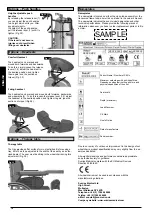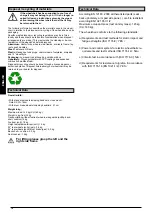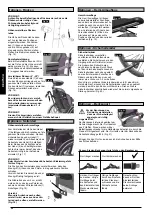
11
Options - Footplates
Footplates:
The footplates can be flipped up to make it easier to transfer to/from
the chair.
Lower leg length:
For users with longer legs, the leg support can be lowered to the ap
-
propriate level by using the screws (1). Loosen the screws, push the
tubes to the desired position and then
re-tighten the screws (see section
on torque). There must always be a
minimum gap of 2.5 cm between the
footplates and the ground.
Angle-adjustable footboard
This can be adjusted to alter the an
-
gle to the ground. Release screw (2),
pull it inwards, set the desired angle
and then push it on. After making
the adjustment, retighten the screw.
Make sure that after any adjustment
work, all screws are tightened correctly (see the page on torque).
Ensure that you maintain the minimum gap to the floor (2.5 cm) .
Option Elevating legrest
To remove, pull the lever (2), swing the footplate outwards and then
lift the legrest out.
To elevate:
Take the load off the footrest and release the
hand wheel (1). Pull the footrest upwards
and adjust to the desired height. Secure the
desired height by tightening the hand wheel.
To lower:
Take the load off the footrest by lifting the
lower leg and release the interlock with the
hand wheel (1) . In this way you can swing
the footrest downwards. As soon as you have
reached the desired position, secure the interlock with
the hand wheel. You can set the lower leg length by releasing the
screws (2), this is infinitely adjustable.
CAUTION:
Keep hands clear of the adjustment mechanism between, the
frame and the movable parts of the footrest while elevating or
lowering the footrest.
CAUTION:
The footrests should not be used to
lift or to carry the wheelchair.
CAUTION: Risk of trapping fingers!
When moving the footrest up or
down, do not put your fingers in the
adjusting mechanism between the
moving parts of the footrest.
Adjusting the calf pad
The calf pad can be adjusted as fol
-
lows:
Height: Open bolt (3 Fig. 11) and
move the clamping piece to the
desired position. By rotating the
clamping piece also the angle can be
adjusted.
Depth: Open bolt (1) and move the calf pad into the desired position.
Width: Open bolt (1) and position the spacers (2) to get the desired
position (Fig. 12).
Caution:
Always make sure that the fasteners are secure
.
Option70° legrest
The legrests can be swung inwards under
the seat sling or outwards. When fitting
the legrests, the footrests must be pointing
inwards or outwards. Then rotate the legrest
inwards, until it locks into place. To remove,
pull the lever (1), swing the footplate inwards
or outwards and then lift the legrest out.
Make sure that the legrest is locked into
Option Amputee support
The amputee support can be
adjusted in every direction, as
required (Fig. 14).
Options - Castors
The wheelchair may veer slightly to the right or left, or the castors
may wobble. This may be caused by the following:
• Forward and/or reverse wheel motion has not been set properly.
• The castor angle has not been set correctly.
• Castor and/or rear wheel air pressure is incorrect; the wheels do
not turn smoothly.
The wheelchair will not move in a straight line if the castors have not
been properly adjusted. Castors should always be adjusted by an
authorised dealer.
Options – Castor adapter
Seat height adjustments:
The seat height is determined by the castor and rear wheel posi
-
tion. The seat height can be adjusted by using different sizes of rear
wheels and by altering the position of the rear wheels and the cas
-
tors and by using spacers.
CAUTION:
After adjusting the seat height, all screws must be re-tightened.
Note:
The castor angle should be set at 90°. Therefore the front and rear
seat height needs to be always the same.
Options - Backrest
Comfort back
The comfort back offers lateral support and
comfortable seating over long periods of time.
The back shell can be removed by turning
the knobs (1) and pushing then outwards. By
moving the back shell forward-upward it will
be released form the guiding hooks.
The cushion is fixed by velcro and can be
removed as well.
Fig. 16
Fig. 15
Fig. 14
place correctly.
CAUTION:
The legrests must not be used to lift or to carry the wheelchair.
CAUTION:
When getting on or off the wheelchair, do not use the foot-
boards. These should be flipped up beforehand and be
swung to the outside as far as possible.
Fig. 10
2
1
Fig. 13
1
1
Fig. 11
1
2
3
Fig. 12
1
2
ENGLISH
Summary of Contents for Breezy Relax2
Page 131: ...131 ...












































